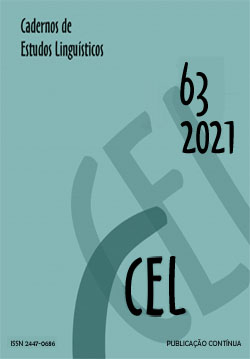Abstract
This paper investigates Latin’s passive syncretism. In that language, the suffix that realizes the passive voice (default: -r) is also found in impersonal, anticausative and middle constructions, as well as in deponent verbs. Building upon previous works of Schäfer (2008) and Lazzarini-Cyrino (2015), and under the framework of Distributed Morphology (HALLE & MARANTZ, 1993; MARANTZ, 1997), we present a derivational proposal which argues that the syncretic marker is a non-referential argument – a variable – which is incorporated into the verb post-syntactically. The several interpretative contexts in which the marker appears in result from the original position it occupied and from its interaction with different flavors of Voice (FOLLI & HARLEY, 2005). If this variable is an external argument, there won’t be any other DP for it to be bound with, and it will remain without a θ-role and Case. Without a θ-role, it is read as an expletive at LF. The absence of Case is a problem for PF (LEVIN, 2015) and, in order to prevent the derivation from crashing, the variable incorporates into the verbal domain by means of Local Dislocation, in the terms of Levin (2015). Passive voice and impersonals result from the incorporation of the variable in the external argument position of a VoiceDO. The same configuration, but with a VoiceCAUSE, produces anticausatives. In middle contexts, the variable is also introduced in the external argument position, but it’s the argument of an Appl head (PYLKKÄNEN, 2008) that is promoted to syntactic subject. Deponents are divided into three types: we propose the agentive ones are in fact middle verbs, and so are derived in the same way; experiencer-subject deponents project that argument via an EXP head and the variable occupies the canonical external argument position; anticausative deponents result from the incorporation of Appl or EXP’s argument in a Voice-less structure.
References
ALEXIADOU, Artemis. Where is non-active morphology. Proceedings of the 20th conference on Head-driven phrase structure grammar, p. 244-262, 2013.
ALEXIADOU, Artemis; ANAGNOSTOPOULOU, Elena; SCHÄFER, Florian. The properties of anticausatives crosslinguistically. Phases of interpretation, v. 91, p. 187-211, 2006.
BAKER, Mark C. Incorporation: A theory of grammatical function changing. 1988.
CARVALHO, Janayna Maria da Rocha. A morfossintaxe do português brasileiro e sua estrutura argumental: uma investigação sobre anticausativas, médias, impessoais e a alternância agentiva. Tese de Doutorado. Universidade de São Paulo, 2016.
EMBICK, David. Unaccusative syntax and verbal alternations. In: ANAGNOSTOPOULOU, Elena; ALEXIADOU, Artemis; EVERAERT, Martin (eds.). The unaccusativity puzzle: Explorations of the syntax-lexicon interface, Oxford University Press, p. 137-158, 2004.
EMBICK, David. The morpheme: A theoretical introduction. Walter de Gruyter GmbH & Co KG, 2015.
EMBICK, David; NOYER, Rolf. Movement operations after syntax. Linguistic inquiry, v. 32, n. 4, p. 555-595, 2001.
EMBICK, David; NOYER, Rolf. Distributed morphology and the syntax/ morphology interface. In: RAMCHAND, Gillian; REISS, Charles (eds.) The Oxford handbook of linguistic interfaces, p. 289-324, 2007.
FARIA, Ernesto. Gramática superior da língua latina. Livraria Acadêmica, 1958.
FOLLI, Raffaella; HARLEY, Heidi. Flavors of v. In: FOLLI, Raffaella; HARLEY, Heidi; KEMPCHINSKY, Paula; SLABAKOVA, Roumyana (eds.) Aspectual inquiries, p. 95-120. Springer, Dordrecht, 2005.
HALLE, Morris; MARANTZ, Alec. Distributed morphology and the pieces of inflection. In: BROMBERGER, Sylvain (ed.). The View from Building 20: Essays in linguistics in honor of Sylvain Bromberger, p. 111-176, 1993.
HARLEY, Heidi. Getting morphemes in order: Merger, affixation, and head movement. Diagnosing syntax, p. 44-74, 2011.
HARLEY, Heidi; NOYER, Rolf. Formal versus encyclopedic properties of vocabulary: Evidence from nominalizations. The lexicon-encyclopedia interface, p. 349-374, 2000.
HEINAT, Fredrik. Why phrases probe. The Department of English in Lund: Working Papers in Linguistics, v. 5, p. 33-63, 2005.
HEINAT, Fredrik. Probes, pronouns, and binding in the minimalist program. The Department of English in Lund: Working Papers in Linguistics, v. 6, p. 19-37, 2006.
HEINAT, Fredrik. Binding condition C and derivation by phase. Manninen & Paradis, 2002.
KEMMER, Suzanne. The middle voice. John Benjamins Publishing, 1993.
KRATZER, Angelika. Severing the external argument from its verb. In: ROORYCK, Johan; ZARING, Laurie (eds.) Phrase structure and the lexicon, p. 109-137. Springer Science & Business Media, 1996.
LAZZARINI-CYRINO, João Paulo. O sincretismo passivo-reflexivo: um estudo translinguístico. Tese de Doutorado. Universidade de São Paulo, 2015.
LEVIN, Theodore Frank. Pseudo noun incorporation is M-Merger: evidence from Balinese. LSA Annual Meeting Extended Abstracts, p. 18-1-5, 2014.
LEVIN, Theodore Frank. Licensing without case. PhD dissertation. MIT, 2015.
MARANTZ, Alec. No escape from syntax: Don't try morphological analysis in the privacy of your own lexicon. University of Pennsylvania Working Papers in Linguistics, v. 4, n. 2, p. 14, 1997.
MASSAM, Diane. Pseudo noun incorporation in Niuean. Natural Language & Linguistic Theory, v. 19, n. 1, p. 153-197, 2001.
NOYER, Rolf. Features, Positions and Affixes in Autonomous Morphological Structure. Garland Publishing, New York, 1997.
ÖZTURK, Balkiz. Pseudo-incorporation of agents. University of Pennsylvania Working Papers in Linguistics, v. 11, n. 1, p. 17, 2005.
PESETSKY, David Michael. Zero syntax: Experiencers and cascades. MIT press, 1996.
PREMIGER, Omer. Agreement as a fallible operation. PhD dissertation, MIT, 2011.
PYLKKÄNEN, Liina. Introducing arguments. MIT press, 2008.
SAAB, Andres. Deconstructing Voice: The syntax and semantics of u-syncretism in Spanish. 2020.
SCHÄFER, Florian. The syntax of (anti-) causatives: External arguments in change-of-state contexts. John Benjamins Publishing, 2008.
TRAVIS, Lisa de Mena. Parameters and effects of word order variation. PhD dissertation. MIT, 1984.
XU, Zheng; ARONOFF, Mark; ANSHEN, Frank. Deponency in Latin. Proceedings of the British Academy. Oxford University Press Inc., 2007.

This work is licensed under a Creative Commons Attribution-NonCommercial 4.0 International License.
Copyright (c) 2021 Cadernos de Estudos Linguísticos


